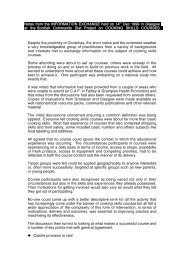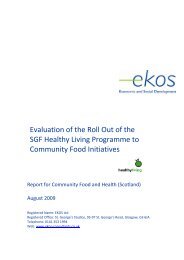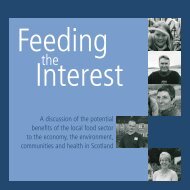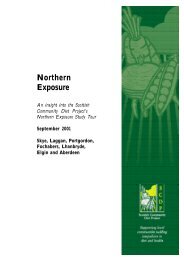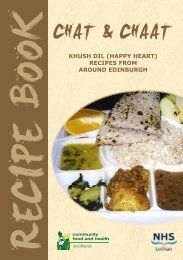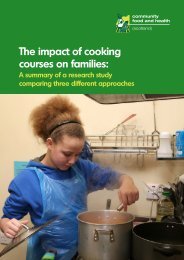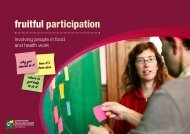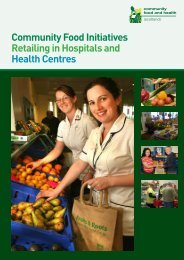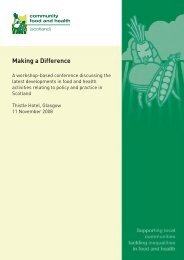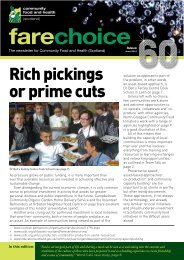Fare Choice Issue 7 - Community Food and Health
Fare Choice Issue 7 - Community Food and Health
Fare Choice Issue 7 - Community Food and Health
Create successful ePaper yourself
Turn your PDF publications into a flip-book with our unique Google optimized e-Paper software.
<strong>Fare</strong> <strong>Choice</strong><br />
Schools in Focus<br />
Gardner Merchant are well known school caterers who need to tune into their target<br />
group hence the production of the most recent research report ”What are today’s<br />
children eating” (1998). The report produces a succinct review of the dietary<br />
habits of 1,372 children aged 7-16 <strong>and</strong> views of 1,174 of their parents.<br />
Findings<br />
! 18% girls aged 15-16 skip breakfast 12% boys aged 15-16 skip breakfast<br />
! Children have considerable amount to spend on the 3 “C’s” Crisps, Confectionery <strong>and</strong> Canned drinks. The<br />
average spent on the way to school is 52p.<br />
! On returning home from school, crisps (<strong>and</strong> savoury snacks) are the most popular foods consumed (38%)<br />
followed by biscuits (27%) <strong>and</strong> fizzy drinks (25%).<br />
! On average children eat crisps 2.5 times per week.<br />
! Most popular “main courses” a) pizza, b) chips, c) roast dinner, d) burgers, e) sausages.<br />
! 24% of boys aged 15-16 buy hot food from local food shops at lunch time.<br />
! 52% parents said they are not getting enough information about school meals.<br />
! 50% of parents said they could either definitely or probably pay extra if they believed the st<strong>and</strong>ard of food<br />
would improve.<br />
These results somewhat confirm recent trends in grazing, high fat choices <strong>and</strong> parental concerns over school<br />
food. Here then lies the challenge <strong>and</strong> one which the Department of Education <strong>and</strong> Employment (South of the<br />
border) is responding to in their consultation paper on Nutritional St<strong>and</strong>ards for School Lunches (“Ingredients for<br />
Success”, DFEE, 1998). The paper is for consultation in Engl<strong>and</strong>.<br />
The introduction of national minimum nutritional st<strong>and</strong>ards <strong>and</strong> other nutritional requirements for<br />
school lunches<br />
! A school lunch will not necessarily have to be a hot meal to meet nutritional st<strong>and</strong>ards. Local Education<br />
Authorities <strong>and</strong> schools should decide whether they wish to provide hot or cold food. [Look forward to seeing<br />
the Veggies with the s<strong>and</strong>wich]<br />
! The government will set food-based nutritional st<strong>and</strong>ards for school lunches, based as the balance of good<br />
health. These st<strong>and</strong>ards will not ban the use of individual foods in school lunches. [Great opportunity for<br />
deep-fried MARS bars here!]<br />
! There will be no need to calculate the nutrient content of the food provided routinely but intermittent evaluation<br />
of the nutrient will still be needed. [Let’s not look at the fat content too often]<br />
! The st<strong>and</strong>ards will be introduced by legislation. [Not that we know what “the st<strong>and</strong>ards” are]<br />
! “To help catering staff to put into practice the national st<strong>and</strong>ards, we will issue practical, non-binding guidance<br />
on preparation <strong>and</strong> cooking methods”. [Let the caterers make the decision]<br />
! No plans to influence customers to make healthy choices such as the positioning of food on the servery or<br />
pricing strategies. [Concealed somewhere under the doughnuts is an apple]<br />
The st<strong>and</strong>ards aren’t set out in this document but an example is the fruit juice should be offered every lunch time<br />
(this one offers more hope!)<br />
And finally please note that a school lunch is defined as<br />
“<strong>Food</strong> made available for consumption by the pupil as midday meal on a school day, whether<br />
including a set meal or the selection of items by him or otherwise”<br />
My guess is that the food industry <strong>and</strong> caterers will welcome this document whole heartedly whilst health<br />
professionals <strong>and</strong> parents will wonder if it is worth it. Indeed the scope to maximise junk food provision is enormous.<br />
As a consultation document it does not inspire. Lets hope we get it right in Scotl<strong>and</strong>.<br />
NUTRITION<br />
NEWS ...<br />
FROM AROUND THE WORLD<br />
by ProfAnnieAnderson<br />
University ofDundee<br />
Note The st<strong>and</strong>ards will not apply to tuckshops, vending machines, breakfast provision, mobile vans near schools<br />
or packed lunches. [What happened to the concept of the whole school approach]<br />
REFERENCES<br />
What Are Today’s Children Eating The Gardner Merchant School Meals Survey, 1998 (p75).<br />
Ingredients for Success: A consultation paper on Nutritional St<strong>and</strong>ards for School Lunches, DFEE (Engl<strong>and</strong>)<br />
(Free).



